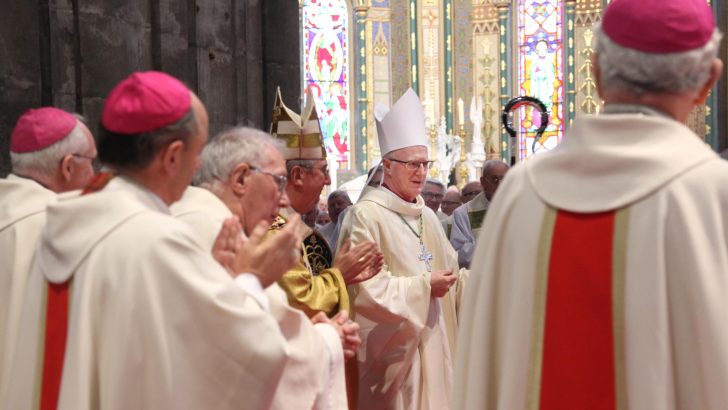Extensive changes in Ossory are about being fit for mission, Bishop Dermot Farrell tells Chai Brady
“To live is to change, and to be perfect is to have changed often” – so wrote the recently-sainted Cardinal John Henry Newman. The Church in Ireland, much like the wider society, has experienced change of epic proportion in recent decades. While society has secularised at a fast pace, the Church’s fall from a central position has been no less dramatic.
As the Church continues to face change – including an ageing clergy, fewer vocations and a decline in faith practice – the challenge for Catholics is whether one embraces and effects change or a spirit of passivity.
Bishop Dermot Farrell is just over 18 months at the helm of the Diocese of Ossory and has been undertaking an extensive discernment process with priests, people and religious.
These conversations have led to the establishment of 13 pastoral areas, gathering parishes into groups with the aim of supporting each other and sharing resources.
“These groupings will permit our individual parishes to become stronger, more alive, and be in a position to offer an even greater level of service in their communities,” Bishop Farrell writes in a pastoral letter to be read at all Masses this weekend.
He insists that the conversations that have been taking place have also explored practical aspects to the life of the Church, most immediately this will be seen in new Mass times in every parish beginning on December 1.
Speaking to The Irish Catholic this week, Dr Farrell said the changes came about after widespread consultation. “What we have done is we have re-organised the Mass schedule across all of the parishes so each pastoral area met, and decided the number of Masses that might be appropriate to their current needs”.
Before the changes, there were 140 Sunday Masses in Ossory, from December 1, that will fall to 92 – a drop of a third.
Practically, Dr Farrell says, this will mean a parish might go from two Saturday evening Masses to one. Also, rather than duplicating Mass times, neighbouring parishes will work together.
However, it is clear that “it’s not just about Masses”.
“You’re looking at baptismal teams, so rather than having three baptismal teams in say one small area you would have one baptismal team who would migrate from parish to parish.
“Basically anything that we can do together, the idea was that we do that together rather than separately, so the idea is that parishes work together,” he said.
Synodal approach
Taking up the call of Pope Francis, Bishop Farrell said that “it was a synodal approach to the issue.
“We met as a diocese initially, with the laity and the priests, the idea was then that we would look at the diocese and try and identify pastoral areas, small units…The idea then was that each of those areas would go out and they would meet together with members, some people with each of the pastoral councils and the priests in the parishes, and each of them would look at the situation in the pastoral area and see where they could work together,” he said.
The bishop is hopeful that the consolidation will also lead to improved liturgies because talent can be focused and priests are not burdened with running from Mass to Mass in the same way as before.
When priests are working in a parish that is not his own, the idea is that they would be truly present. “They are encouraged to swap pulpits, while a priest is assigned to a particular parish as a parish priest, the recommendation is certainly a few times a year that he would actually celebrate Mass in the other parishes and the other priest in that parish would celebrate Mass in his parish. So that for example when he has to do a funeral, he’s not just somebody who appears out of nowhere, that he is known to the people in that parish,” according to Bishop Farrell.
We can’t keep multiplying the number of Masses, that doesn’t make for good liturgy”
Ossory is facing the same challenges as other dioceses with the average age of priests in the late 60s and just four priests under the age of 50.
However, that is only part of the issue. “I suppose our problem is not the shortage of priests: the bigger issue is that we have far more infrastructure than we need.
“Going forward we will not be able – in time – to celebrate Mass every Sunday in every church that we have,” he said. Already, there are some churches that do not have Mass every weekend.
“Ossory – and every parish in the country – was in a somewhat similar situation where you had parishes that had two to three priests and now have one priest, and we have some parishes that we’ve no resident priest, in other words a parish priest is looking after two parishes rather than one: with a couple of smaller parishes which one man has been assigned to both,” he said.
****
But what about resistance from parishioners? Dr Farrell is convinced that people “are very much grounded in reality. They know things have changed, that there are fewer priests available”.
The seat of the diocese is the City of Kilkenny and like many urban areas it has plenty of churches. It is something the bishop is conscious of. “I can walk, which I do regularly, to all the churches in the city – the most it would take me is 15 minutes.
“There’s 10 churches: do we need 10 churches? No. The answer is historically we have these and they’re part of the history of the city but we can’t keep multiplying the number of Masses [that priests say], that doesn’t make for good liturgy and also the other issue is if you have a small congregation: having multiple small congregations can be demoralising, it’s much better from the point of view of people who walk into a church that there’s a decent congregation there,” Bishop Farrell insists.
For Ossory, it is about trying to be proactive. “What I don’t want is if a priest gets ill or a priest dies you’re scrambling to provide services to that parish. There is a structure in place that can deal with things like illness should it happen suddenly, or if so – die suddenly, you’re not wondering how am I going to provide for Mass here next Sunday,” Dr Farrell says.
Time and again, the issue of ordaining married men comes to the fore when people consider the challenges facing the Church. But for Bishop Farrell, the issue is much deeper than the shortage of priests.
He is frank: “That is a Faith issue fundamentally. If you look at the shortage of vocations the issue there is the faith, because people say ‘why don’t we ordain married men?’ But if you look down the church on a Sunday, you say ‘well where are they going to come from?’
“It’s not going to be solved by just ordaining married men or even deacons. You look down the church and say ‘well where are the deacons going to come out of?’ It is a crisis of faith we’re dealing with fundamentally,” he said.
On the Amazon Synod – where the Pope was requested to look at the issue of ordaining married men – the bishop is clear that it is comparing apples with oranges. It is, he says, “a completely different reality to what we have…in the Amazon, you have whole tracks of territory the size of Ireland with one priest. We’re a long, long, long way from there. We do not at the moment have a shortage of priests, what we have is a surplus of infrastructure and we can’t go on maintaining that infrastructure or providing services in all of it as we have here before – nor indeed do we need to”.
He is not hostile to the idea of married priests, but knows that it is no magic wand. “I think that [married priests] is a possibility yes, certainly something that could be considered in the future, but as I said you still have the problem: where are they going to come from?
“I suppose, ultimately, it’s about reading the signs of the times, when that comes we have to read the signs of the times in terms of how we’re going to deal with that situation in another point in time,” he says.
On the issue of the female diaconate – much debated at the moment – Dr Farrell returns to the theme of reading the signs of the time and interpreting them “in the light of the Gospel. That’s an essential task for the Church in any diocese.
Pope Francis is certainly looking at that [women deacons] and he had a commission looking at the historical evolution of the role of women in the Church. I think what he did indicate was that he was going to look at that with a slightly different criteria in the months ahead, so I suppose we await that.
What we have is a surplus of infrastructure and we can’t go on maintaining that”
There is no obvious hint of nostalgia or sentimentality in the Bishop of Ossory, more a sense that change is simply a fact of life. “I’m ordained 40 years next year: when I think of the enormous change that’s taken place over my lifetime in the priesthood that’s having a huge impact on the role and the understanding of the Church in the diocese here in Ossory and indeed in Ireland.
“It’s reflected in the number of candidates that present for the priesthood. When I went to Maynooth, I think there were 64 in my class – that’s far more than in seminary formation in Ireland today.
“That situation is always going to have an impact on the form of ministry, and how it’s going to be taken in a changing environment, and that environment – I’ve no doubt – will change in the years ahead. So how do you understand the role of the priest? I would have understood the role of the priest 40 years ago and today is somewhat different,” according to Dr Farrell.
He is not naïve about the task ahead. “I think it will be challenging, and it is challenging at the moment. I can’t see that changing rapidly, there’s not going to be an exponential increase in vocations.
“We’re trying to speak to that, we’re reading the signs of the times and trying to respond to that as best we can,” he says,


 Chai Brady
Chai Brady Photo: John Mc Elroy.
Photo: John Mc Elroy.